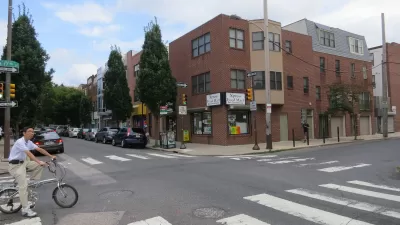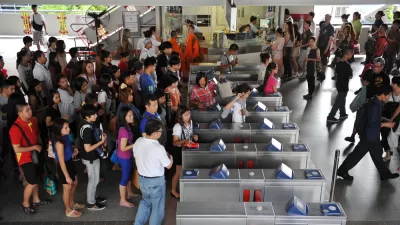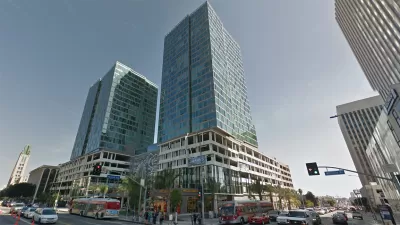Architecture critic Christopher Hawthorne describes an L.A. in flux, at once beholden to its postwar image and pushing in a new direction. The city, he says, faces existential questions on a scale unmatched elsewhere in the nation.

In an interview, Christopher Hawthorne discusses why L.A. may be entering its third great incarnation. "All of us continue to be disappointed by how much of the reading of L.A. just assumes that the city started in 1930 or 1945 [...] Southern California was really built around the convenient marriage between streetcar lines and real estate speculation. That laid down the network on top of which the freeways were built."
After post-WWII suburbanization replaced an older car-less Los Angeles, today's push for public infrastructure is both reversal and revolution. Hawthorne remarks, "An easy way to think about what's happening is there was a time when nine out of every ten changes to a boulevard in L.A. were done with the idea of drivers in mind. Parking lots were added, sidewalks shrunk, buildings were destroyed along boulevards. Now the opposite is true; the vast majority of changes to boulevards are in favor of a balanced street."
Following an era suited to the individual, the city is considering its collective ambitions. "A lot of the basic ways in which the city defines itself are up for grabs in a way that's not true in any other major American city that I can think of. It's not true in San Francisco, New York, or Chicago. Those cities are in many ways fixed. In L.A., existential questions are still up for grabs."
L.A.'s "third era" may well include architectural rediscovery in the public space. Hawthorne says, "[L.A. has] become a very constrained, regulated, and risk-averse place in terms of new architecture. That's still surprising for people outside of L.A. to hear [...] We do have a great history of public space and civic architecture that we lost sight of."
FULL STORY: Q+A> Christopher Hawthorne: Christopher Hawthorne makes the case for a post-suburban city

Alabama: Trump Terminates Settlements for Black Communities Harmed By Raw Sewage
Trump deemed the landmark civil rights agreement “illegal DEI and environmental justice policy.”

Planetizen Federal Action Tracker
A weekly monitor of how Trump’s orders and actions are impacting planners and planning in America.

The 120 Year Old Tiny Home Villages That Sheltered San Francisco’s Earthquake Refugees
More than a century ago, San Francisco mobilized to house thousands of residents displaced by the 1906 earthquake. Could their strategy offer a model for the present?

In Both Crashes and Crime, Public Transportation is Far Safer than Driving
Contrary to popular assumptions, public transportation has far lower crash and crime rates than automobile travel. For safer communities, improve and encourage transit travel.

Report: Zoning Reforms Should Complement Nashville’s Ambitious Transit Plan
Without reform, restrictive zoning codes will limit the impact of the city’s planned transit expansion and could exclude some of the residents who depend on transit the most.

Judge Orders Release of Frozen IRA, IIJA Funding
The decision is a victory for environmental groups who charged that freezing funds for critical infrastructure and disaster response programs caused “real and irreparable harm” to communities.
Urban Design for Planners 1: Software Tools
This six-course series explores essential urban design concepts using open source software and equips planners with the tools they need to participate fully in the urban design process.
Planning for Universal Design
Learn the tools for implementing Universal Design in planning regulations.
Clanton & Associates, Inc.
Jessamine County Fiscal Court
Institute for Housing and Urban Development Studies (IHS)
City of Grandview
Harvard GSD Executive Education
Toledo-Lucas County Plan Commissions
Salt Lake City
NYU Wagner Graduate School of Public Service





























